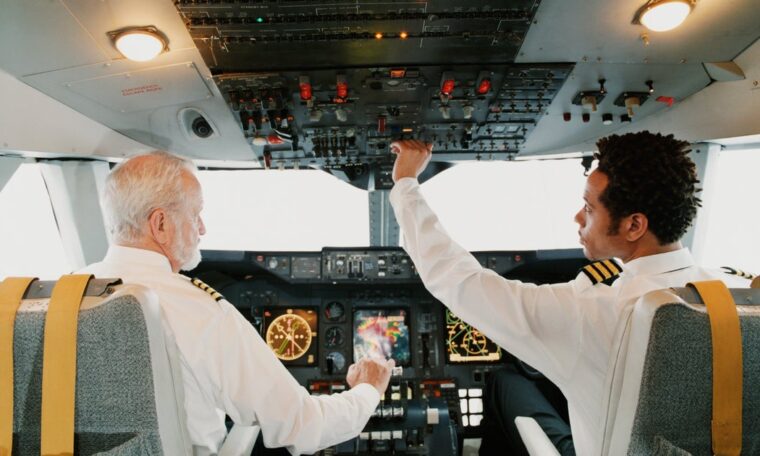
Myths and misconceptions surround the job of a pilot. While Hollywood often glamorizes the cockpit, the day-to-day reality is far more complex and human.
From assumptions about who’s in the cockpit to what their schedules look like at home, myths about aviation persist. To separate fact from fiction, HuffPost asked pilots to share the truths behind the most common misconceptions about their profession.
Myth: Autopilot does all the work.
“It’s a myth that pilots just push ‘autopilot’ and the plane flies itself so pilots can just sit back and relax or sleep,” Scott Place, a captain with Delta Air Lines, told HuffPost. “Modern aircraft are highly automated, but pilots are constantly monitoring systems, making decisions and handling unexpected situations.”
He added that pilots are allowed to sleep only under strict conditions on long-haul flights with designated rest periods and relief pilots.
“Yes, autopilot helps, but it doesn’t replace the pilot,” said pilot and psychotherapist Michaela Renee Johnson. “It’s like cruise control in a car ― convenient, but you’re still steering, monitoring and ready to take over at any moment. The true work lies in decision-making, problem-solving and keeping everyone safe.”
Myth: Pilots are adrenaline junkies.
“Another common myth is that pilots are adrenaline junkies,” said pilot and blogger Mindy Lindheim. “In truth, most pilots are highly risk-averse.”
She noted that safety and risk management are emphasized above everything else from day one of training.
“Pilots are trained to identify risks early and avoid them whenever possible to protect not only themselves, but also their passengers and people on the ground,” Lindheim said.
Myth: Pilots never get to spend time with their families.
Their schedules might look unconventional, but that doesn’t mean pilots are inherently absent parents or partners.
“Pilots typically work in blocks of flying days followed by several consecutive days off, allowing for extended quality time at home,” Place said. “And as pilots gain seniority, they have more options over their schedules, making it easier to align work with family life.”
Myth: Pilots can fly any plane at any given time.
“Pilots must undergo specific training for each type of aircraft they fly,” Place said.
He noted that his employer, Delta, requires a certification for each aircraft to prove the pilot is qualified to operate that particular model.
“As an example, flying a Boeing 737 or Airbus A320 requires a separate rating specific to that aircraft,” Place said. “Even though both are commercial jets, their systems, handling characteristics and procedures differ significantly.”
Myth: Pilots are all men.
It’s one of the most persistent stereotypes in aviation, but women have long been flying ― and leading ― in every corner of the industry.
“This one’s personal,” Johnson said. “While aviation is still male-dominated, women have been at the controls for decades ― and not just as ‘rare exceptions.’ We’re captains, instructors, aerobats and air racers. Breaking this myth matters because it helps the next generation see aviation as a real path for them.”
Myth: The lifestyle is glamorous all the time.
Sure, the uniform and travel perks might look sleek from the outside, but day-to-day pilot life is not quite so glam.
“Hollywood loves to romanticize aviation, but the truth is long hours, jet lag and sometimes eating a granola bar for dinner at 2 a.m.,” Johnson said. “The glory of being a pilot isn’t the glamor ― it’s the privilege of seeing the world from a perspective few people ever do.”
Digital Vision. via Getty Images
It’s a myth that autopilot “does al the work.”
Myth: Pilots must be exceptional at math.
“One of the biggest myths about pilots is that they must be exceptional at math,” Lindheim said. “In reality, pilots only need basic mental math skills for quick calculations during flight planning or in the cockpit. Modern pre-flight planning tools and in-flight equipment handle most of the heavy lifting, though pilots still need to verify and double-check calculations themselves.”
She added that the math required is relatively straightforward, rather than advanced or overly complex.
Myth: Pilots are always ex-military.
“While military experience can be beneficial ― and we’re proud that more than 35% of our pilots are active or veteran military members ― it’s not a requirement for becoming a commercial pilot,” Place said.
He noted that aspiring pilots can pursue this career through various pathways that don’t involve the military, such as collegiate programs, flight schools, or structured training programs offered by airlines themselves.
Myth: Pilots stay locked in the flight deck to avoid interacting with customers.
20 Years OfFreeJournalism
Your SupportFuelsOur Mission
Your SupportFuelsOur Mission
For two decades, HuffPost has been fearless, unflinching, and relentless in pursuit of the truth. Support our mission to keep us around for the next 20 — we can’t do this without you.
We remain committed to providing you with the unflinching, fact-based journalism everyone deserves.
Thank you again for your support along the way. We’re truly grateful for readers like you! Your initial support helped get us here and bolstered our newsroom, which kept us strong during uncertain times. Now as we continue, we need your help more than ever. We hope you will join us once again.
We remain committed to providing you with the unflinching, fact-based journalism everyone deserves.
Thank you again for your support along the way. We’re truly grateful for readers like you! Your initial support helped get us here and bolstered our newsroom, which kept us strong during uncertain times. Now as we continue, we need your help more than ever. We hope you will join us once again.
Support HuffPost
Already contributed? Log in to hide these messages.
“Pilots remain in the flight deck during flight for safety and operational reasons ― not to avoid customers,” Place said. “A pilot’s primary responsibility is to ensure a safe and smooth journey, which requires constant communication with air traffic control, monitoring systems and managing flight operations.”
Still, he added, he and his colleagues enjoy connecting with passengers at other opportunities, like before boarding and after landing.
“Whether it’s greeting customers or inviting young flyers to explore the flight deck, these moments are incredibly important to our pilots,” Place added.
Source link
CHECK OUT: Top Travel Destinations
READ MORE: Travel News



